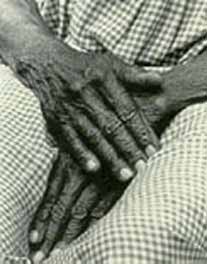|

|
|
A Ritual Tradition: Midwifery Among Southern African-Americans
|
In the 1970s Southern states ended the licencing of new midwives and only allowed registered
nurse-midwives. To achieve their goals of eradicating the age-old network of Southern African-American midwives,
they had to gradually phase out the old system by temporarily incorporating the two.
Since slavery, black women had provided midwifery services to black and white women. Before and after Emancipation,
black women relied upon one another for medical care, and among them were not only midwives, but folk doctors well-versed
in herbal remedies. In trying to care for themselves and their families, black women developed relationships with
church, neighborhood, and strong family ties. |
|

|
Race and economics usually decided where and by whom African-American women would have their babies delivered.
Those who could not afford or were not admitted to a hospital would have theirs at home, some with a hired midwife,
some with the help on a family member, and some delivered themselves while waiting for help. Most hospitals were
segregated and white, and white nurses were not permitted to admit black patients. There were some clinics who
admitted blacks and some black hospitals, but they were few and located mainly in the bigger towns and cities,
so often went unused by rural women. Many women were suspicious of medicine they did not understand and, finding
it more comfortable and less costly to stay at home with a midwife, would refuse to be convinced to admit themselves. |
| An African-American midwife was usually trained by her mother or another close female relative. She would generally
arrive when labor pains began and stay to guide the delivery until the mother was conscious and comfortable, and
would sometimes even return for a check-up after three days to a week. She would often work on credit, or accept
produce or other foodstuffs as payment for her services. Black rural midwives also had to deal with grossly impoverished
households. Some families were reportedly too poor for a barn, and the goats and pigs slept under the delivery
bed. Some had no furniture and too little coal to heat their tiny cabins. Some were even too poor to provide any
clothing for the newborn. Midwives were known to help these people as best as they could. |

|
|

|
Black rural women, midwife or not, utilized to the fullest capacity the wild herbs and roots that grow in the South.
Their uses were a great many: painkillers for cramps, labor-inducers, and even to bring an over-due period. Some
of these herbs included black haw, pepper, mayapple root, ginger root, dirt dauber, and tread sash tea. Older women
also insisted that mothers of a younger generation follow sets of "guidelines" for postnatal care. Some
of these practices were hanging the mother's clothes in the chimney and "smoking them," burning the clothing
with birth blood stains, walking the mother around the house with a thimble of water, not eating fish, and burying
cotton seed under the doorstep. The meanings behind these ritual acts were often unknown, but mothers were compelled
to perform them just the same because of the tradition of and belief in their effectiveness. |
| At the beginning of the twentieth century, the United States government became concerned with infant mortality
rates and stepped in to examine the system. Doctors and nurses were never studied thoroughly, but rural black midwives
were a target for scrutiny. In 1918 a state law passed in Alabama requiring practicing midwives to attend a short
course at Tuskegee Institute to learn about basic hygiene and simple domestic tasks. Women who completed the course
were often more respected as midwives in their communities. |
| In 1931, there were 3,568 midwives in Alabama working for and supervised by lealth departments in 54 of the 67
counties. Almost all black women had their babies by a midwife, and black midwives served a large percentage of
the white community as well. White doctors were frustrated by the low health standards in poor black communities,
but were either unable or unwilling to help them. They were disapproving of the methods of midwifery, seeing them
as old-fashioned. They discouraged particularly white women from calling for midwives, but charge too much money
for black Southerners at that time to afford. |

|
|

|
In the 1930s and ‘40s, a Social Security act provided more children's clinics and midwife training programs. Knowing
that they could not expel midwifery completely from black tradition right away, the Board of Health wanted to educate
the midwives who were left, and go back later to revoke their certifications when their services were no longer
needed because of new clinics. Midwives could work for the Board of Health under a doctor if they could exhibit
strong morals and cleanliness, and if they passed the exam to practice. Most women were experienced and so passed
easily, but they still had to follow a new set of intrusive guidlelines. The state-issued guidelines were strict
and tended to reflect popular medicine of the time. Micwives learned carry two doctor's bags with them; one to
pass inspection and one to really use. |
They were not permitted, under threat of revoked licence, to use any traditional methods, even separating the baby
from the other after birth, but they often felt it was best to honor the wishes of the new mother and so broke
or bent the rules to suit.
Lay-midwifery was completely outlawed in the 1970s, and with this a strong bond between women in the African-American
community was broken. They were forced to depend on outsiders for the medical care they had always held so tightly
within the community, and to give up the traditions that they had been practicing for generations. |
|
 
|
![]()